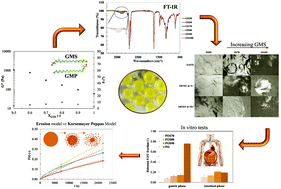Effect of the monostearate/monopalmitate ratio on the oral release of active agents from monoacylglycerol organogels†
Abstract
The delivery of active agents from organogels is becoming an important topic owing to the possibility of releasing, in a controlled way, lipophilic agents. Controlled release from foods is a topic with increasing relevance owing to the growing industrial interest towards functional or medical foods, i.e. foods containing nutraceutical agents or drugs. Anyway, release properties are related to the rheological properties of organogels, and, therefore, a deep knowledge of their microstructure and physical characteristics is necessary to design carriers with expected release properties. In this work, two low molecular weight gelators (i.e. glycerol monopalmitate, GMP, and glycerol monostearate, GMS) have been investigated using rheology, microscopy and infrared spectroscopy, IR, aiming at understanding the effects of different gelator ratios on organogel properties. It was observed that GMP, within the range of investigated compositions, seems to be more effective in yielding consistent organogels and this effect was related to differences in microstructure with respect to GMS. Their ability to control the oral release of active agents was investigated, in vitro, using a chemotherapeutic drug for adenocarcinoma of the gastrointestinal tract, 5 fluorouracil (5-FU). A physical model based on carrier erosion was used to describe the release data, evidencing a good agreement with experimental values. Among the tested samples it seems that the use of 90% of GMS (over total organogelator content) yields promising results allowing a good partition of the released drug between the gastric and intestinal tracts with the largest value (although lower than 40% of loaded amount) of the total released drug.



 Please wait while we load your content...
Please wait while we load your content...